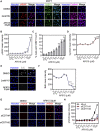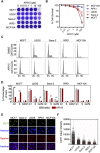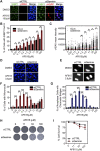Small Molecule Inhibitor Targeting CDT1/Geminin Protein Complex Promotes DNA Damage and Cell Death in Cancer Cells
- PMID: 35548337
- PMCID: PMC9083542
- DOI: 10.3389/fphar.2022.860682
Small Molecule Inhibitor Targeting CDT1/Geminin Protein Complex Promotes DNA Damage and Cell Death in Cancer Cells
Abstract
DNA replication initiation requires the loading of MCM2-7 complexes at the origins of replication during G1. Replication licensing renders chromatin competent for DNA replication and its tight regulation is essential to prevent aberrant DNA replication and genomic instability. CDT1 is a critical factor of licensing and its activity is controlled by redundant mechanisms, including Geminin, a protein inhibitor of CDT1. Aberrant CDT1 and Geminin expression have been shown to promote tumorigenesis in vivo and are also evident in multiple human tumors. In this study, we developed an in vitro AlphaScreen™ high-throughput screening (HTS) assay for the identification of small-molecule inhibitors targeting the CDT1/Geminin protein complex. Biochemical characterization of the most potent compound, AF615, provided evidence of specific, dose-dependent inhibition of Geminin binding to CDT1 both in-vitro and in cells. Moreover, compound AF615 induces DNA damage, inhibits DNA synthesis and reduces viability selectively in cancer cell lines, and this effect is CDT1-dependent. Taken together, our data suggest that AF615 may serve as a useful compound to elucidate the role of CDT1/Geminin protein complex in replication licensing and origin firing as well as a scaffold for further medicinal chemistry optimisation.
Keywords: AlphaScreen; CDT1; Geminin; cancer; high-throughput screening; small molecule inhibitor.
Copyright © 2022 Karantzelis, Petropoulos, De Marco, Egan, Fish, Christodoulou, Will, Lewis, Perrakis, Lygerou and Taraviras.
Conflict of interest statement
The authors declare that the research was conducted in the absence of any commercial or financial relationships that could be construed as a potential conflict of interest.
Figures





Similar articles
-
A Cdt1-geminin complex licenses chromatin for DNA replication and prevents rereplication during S phase in Xenopus.EMBO J. 2006 Dec 13;25(24):5764-74. doi: 10.1038/sj.emboj.7601436. Epub 2006 Nov 23. EMBO J. 2006. PMID: 17124498 Free PMC article.
-
Characterization of conserved arginine residues on Cdt1 that affect licensing activity and interaction with Geminin or Mcm complex.Cell Cycle. 2016 May 2;15(9):1213-26. doi: 10.1080/15384101.2015.1106652. Cell Cycle. 2016. PMID: 26940553 Free PMC article.
-
Cdt1 interactions in the licensing process: a model for dynamic spatiotemporal control of licensing.Cell Cycle. 2007 Jul 1;6(13):1549-52. doi: 10.4161/cc.6.13.4455. Epub 2007 May 22. Cell Cycle. 2007. PMID: 17598984 Review.
-
Functional domains of the Xenopus replication licensing factor Cdt1.Nucleic Acids Res. 2005 Jan 13;33(1):316-24. doi: 10.1093/nar/gki176. Print 2005. Nucleic Acids Res. 2005. PMID: 15653632 Free PMC article.
-
Cdt1 and Geminin in cancer: markers or triggers of malignant transformation?Front Biosci. 2008 May 1;13:4485-94. doi: 10.2741/3018. Front Biosci. 2008. PMID: 18508524 Review.
Cited by
-
BRCA2 reversion mutation-independent resistance to PARP inhibition through impaired DNA prereplication complex function.Proc Natl Acad Sci U S A. 2025 Jun 10;122(23):e2426743122. doi: 10.1073/pnas.2426743122. Epub 2025 Jun 3. Proc Natl Acad Sci U S A. 2025. PMID: 40460119 Free PMC article.
-
Construction of exosome-related genes risk model in kidney cell carcinoma predicts prognosis and immune therapy response.Aging (Albany NY). 2024 May 7;16(9):7622-7646. doi: 10.18632/aging.205767. Epub 2024 May 7. Aging (Albany NY). 2024. PMID: 38728235 Free PMC article.
-
CDT1 is a Potential Therapeutic Target for the Progression of NAFLD to HCC and the Exacerbation of Cancer.Curr Genomics. 2025;26(3):225-243. doi: 10.2174/0113892029313473240919105819. Epub 2024 Oct 4. Curr Genomics. 2025. PMID: 40433415 Free PMC article.
References
LinkOut - more resources
Full Text Sources
Research Materials
Miscellaneous

